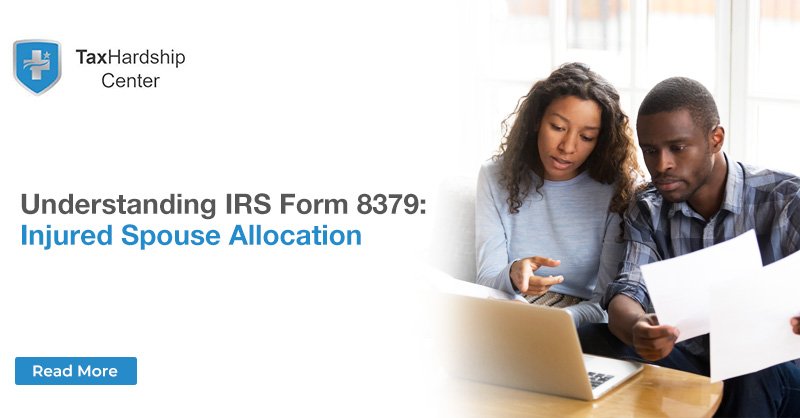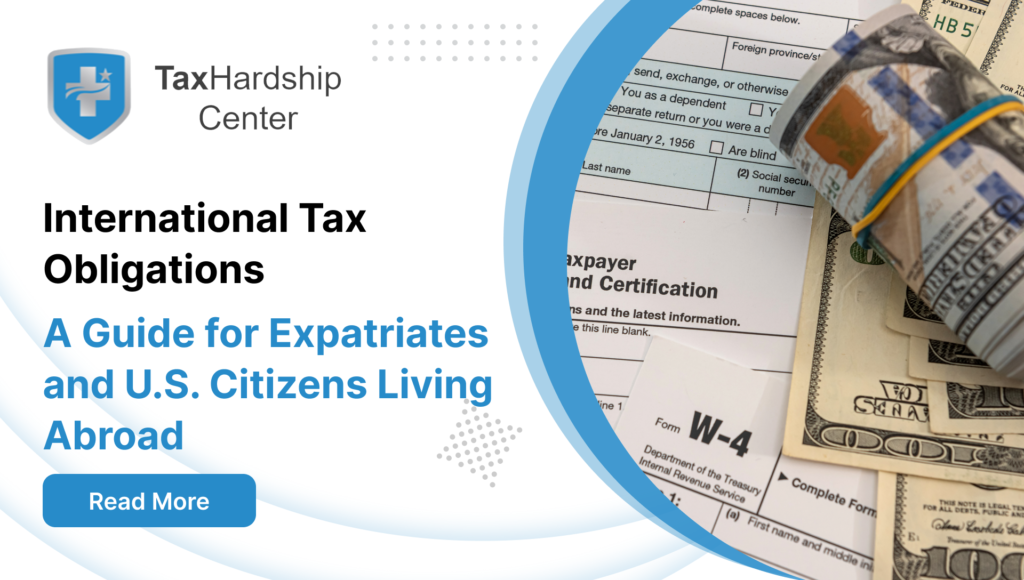When one spouse owes a debt to the IRS, the other spouse may be considered injured. This can happen when the debt is related to unpaid taxes, student loans, or other financial obligations. To protect innocent spouses from having their share of the tax refund seized, the IRS has created Form 8379: Injured Spouse Allocation.
If this seems complicated, Our team of experts at the Tax Hardship Center can work with you to simplify requesting relief as an injured spouse throughout the process.
- Assess your situation and determine your eligibility for injured spouse relief.
- Collect all necessary documents, including your joint tax return and any IRS notices.
- Provide you with IRS Form 8379: Injured Spouse Allocation and explain how to fill it out accurately.
- Help you gather additional supporting documents to strengthen your case.
- Review your completed form and supporting documents to ensure accuracy and completeness.
- Assist you in preparing a compelling written statement explaining your circumstances and the need for relief.
- File the completed form, supporting documents, and written statement on your behalf.
- Monitor the progress of your request and address any additional requirements or inquiries from the IRS.
- Advocate for your rights and negotiate with the IRS to secure the maximum protection for your share of the tax refund.
In this comprehensive guide, we will explain what an injured spouse is, how to qualify for relief, and provide a step-by-step process for requesting and filing Form 8379. We will also address common questions about the injured spouse allocation.
What is an Injured spouse?
An injured spouse refers to a spouse whose portion of a joint tax refund has been taken by the IRS to pay off the other spouse’s debts. It’s important to understand that being an injured spouse does not necessarily mean being liable for the IRS debt.
Qualifying for Injured Spouse Relief: What You Need to Know
To qualify for injured spouse relief, you must meet the following criteria:
1. You have filed a joint tax return with your spouse
2. Your spouse owes a past-due debt (taxes, student loans, etc.)
3. You have reported income on the joint tax return or claimed refundable tax credits
What Is IRS Form 8379: Injured Spouse Allocation?
IRS Form 8379: Injured Spouse Allocation is a form that allows an injured spouse to claim their share of a joint tax refund. By filing this form, the injured spouse can request their portion of the refund to be protected from seizure by the IRS to satisfy the other spouse’s debts.
What to Do If You Receive a Notice
If you receive a notice from the IRS stating that your tax refund will be used to pay off your spouse’s debt, you must take immediate action if you receive a notice from. Instead of ignoring the notice, make sure to review it carefully. Gather all the information and documents required to file Form 8379, which will help you protect your refund portion.
What is the difference between Form 8379 and 8857? Injured vs. Innocent Spouses: Clarifying the Confusion
Understanding the difference between an injured spouse (IRS Form 8379) and an innocent spouse (IRS Form 8857) is essential. An injured spouse is someone whose share of a joint tax refund is seized to satisfy the other spouse’s debts. On the other hand, an innocent spouse is not responsible for the tax debt owed by their spouse.
When to Request the Relief?
Before filing your tax return, you can request relief as an injured spouse. We recommend filing Form 8379 as soon as possible after you become aware of the joint tax refund offset. It helps expedite the process and ensure the timely protection of your refund portion.
How to Request Relief?
To request relief as an injured spouse, follow these steps:
1. Gather all necessary documents, including your joint tax return and any notices received from the IRS.
2. Download or obtain Form 8379: Injured Spouse Allocation.
3. Carefully read and follow the instructions provided with the form.
4. Fill out the form accurately with all the required information.
5. Attach any supporting documents as instructed.
6. Keep a copy of the completed form and all supporting documents for your records.
7. Mail the form and any additional documents to the IRS address provided in the instructions.
Where to download the Forms & Instructions
To download IRS Form 8379 and the instructions, visit the official IRS website. Look for the Forms & Instructions section and search for Form 8379. You can download and print the form or fill it out electronically using tax preparation software.
Filling out the form 8379
When filling out Form 8379, providing accurate and complete information is essential. Pay close attention to details such as your Social Security number, your spouse’s Social Security number, and the income and credits reported on your joint tax return. Any errors or omissions may delay the processing of your request.
Who Can File Form 8379: Injured Spouse Allocation?
Any spouse who meets the qualifying criteria for injured spouse relief can file Form 8379. It does not matter if you are the primary or secondary earner in the household. As long as you meet the requirements, you have the right to protect your share of the joint tax refund.
How can I file Form 8379 electronically?
To file Form 8379 electronically, you can use tax preparation software approved by the IRS. These software programs provide step-by-step guidance and ensure accurate completion of the form. Electronic filing is a convenient and efficient option, as it reduces the chances of errors and speeds up the processing of your request.
Filing With the IRS as an Injured Spouse
When filing Form 8379 with the IRS, keeping copies of all relevant documents, including the completed form and supporting materials, is essential. It will help you track the progress of your request and provide proof of submission if needed.
What happens after You Request Relief?
After you have submitted Form 8379 and requested relief as an injured spouse, the IRS will review your request and determine the appropriate course of action. Be patient during this process, as the IRS may take some time to process and check your request.
When Does the IRS Begin Processing Injured Spouse Forms?
The IRS typically begins processing Form 8379 and other injured spouse forms after filing the tax return. However, it is essential to note that processing times may vary depending on the IRS workload and other factors. You can check the status of your request using the Where’s My Amended Return? Tool on the IRS website.
If not electronically, Where should I mail Form 8379?
The mailing address for Form 8379 depends on your state of residence and whether you are including a payment with your form. The instructions provided with the form will include the correct mailing address for your situation. Double-check the address before mailing your form to ensure it reaches the appropriate IRS office.
Taxes done right, with experts by your side.
Navigating the complexities of the IRS and tax laws can be challenging. Consider seeking the assistance of tax experts or professionals who specialize in helping individuals with Form 8379 and other tax-related issues. Their expertise can ensure that you receive the maximum protection and benefits available to you as an injured spouse.
Final words
Understanding IRS Form 8379: Injured Spouse Allocation is crucial for individuals who find themselves in a situation where their share of a joint tax refund is at risk due to their spouse’s debts. Following the steps outlined in this guide, you can qualify for injured spouse relief and protect your refund portion.
Remember to consult with the Tax Hardship Center for personalized advice and assistance. Don’t let your hard-earned money go to waste – take action and ensure that your rights as an injured spouse are protected.
Frequently Asked Questions:
Q1: Can I file Form 8379 if I am separated from my spouse?
A1: You can still file Form 8379 if you are legally separated from your spouse. Your separation status does not affect your eligibility as long as you meet the qualifying criteria for injured spouse relief.
Q2: Is there a fee to file Form 8379?
A2: No, there is no fee for filing Form 8379 if you decide to do it yourself. It is a free form provided by the IRS to protect the rights of injured spouses and ensure a fair distribution of joint tax refunds.
Q3: Can I file Form 8379 for past years?
A3: You can file Form 8379 for past years if you have a valid reason. However, keep in mind that there are time limitations for claiming refunds. Consult with a tax professional or the IRS for specific guidance on filing for past years.
Q4: Can the IRS deny my request for injured spouse relief?
A4: Yes, the IRS can deny a request for injured spouse relief if they determine that you do not meet the necessary criteria. In such cases, you can appeal the decision or seek further assistance from a tax professional.
Q5: Can I file Electronically if I am requesting injured spouse relief?
A5: Yes, it is possible to file Form 8379 along with your tax return electronically.
Here’s a general idea of the processing times:
- If you electronically file Form 8379 with a joint return, it typically takes around 11 weeks to process.
- If you file Form 8379 with a joint return on paper, the processing time is usually about 14 weeks.
- If you file Form 8379 by itself after a joint return has already been processed, the typical processing time is approximately 8 weeks.








